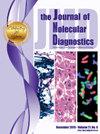整合福尔马林固定,石蜡包埋衍生的全基因组测序常规分子病理学
IF 3.4
3区 医学
Q1 PATHOLOGY
引用次数: 0
摘要
由于新鲜冷冻样品的物流和质量限制,福尔马林固定石蜡包埋(FFPE)肿瘤组织在病理学上是标准的。尽管全基因组测序(WGS)提供了诊断前景,但其在FFPE样本中的有效性和实用性仍未得到充分探索。本研究通过比较ffpe衍生的肿瘤WGS与FoundationOneCDx (F1CDx)和黑色素瘤特异性面板(MelArray)的下一代测序结果,弥合了这一差距,这些结果来自瑞士肿瘤分析研究的78例转移性黑色素瘤样本。利用公共和商业数据库开发了用于质量控制、变体注释和临床可操作性的诊断管道。ffpe衍生的WGS显示出强大的分析有效性,检测出95%的体细胞单核苷酸变异、98%的多核苷酸变异、90%的插入/缺失、76%的扩增和96%的F1CDx鉴定的纯合缺失。肿瘤突变负担与F1CDx密切相关(R = 0.98),特别是在临床阈值≥10个突变/兆酶时,这对治疗决策至关重要。WGS检测复杂的生物标志物,如紫外线相关的突变特征和全基因组拷贝数改变,有助于黑色素瘤亚型的区分。在临床上,WGS建议对所有病例进行治疗或试验,与F1CDx和MelArray相比,分别有38%和71%的人发现了额外的标记物。在18%和56%的病例中发现了新的治疗机会。ffpe衍生的WGS在性能上与目标面板密切匹配,同时提供全面的见解,增强治疗选择。随着成本的降低,WGS可能成为强大的常规诊断工具。本文章由计算机程序翻译,如有差异,请以英文原文为准。
Integrating Formalin-Fixed, Paraffin-Embedded–Derived Whole-Genome Sequencing into Routine Molecular Pathology
Formalin-fixed, paraffin-embedded (FFPE) tumor tissue is the standard in pathology due to logistical and quality constraints of fresh-frozen samples. Although whole-genome sequencing (WGS) offers diagnostic promise, its validity and utility in FFPE samples remain underexplored. This study bridges the gap by comparing FFPE-derived tumor WGS with next-generation sequencing results from FoundationOneCDx (F1CDx) and a melanoma-specific panel (MelArray) in 78 metastatic melanoma samples from the Swiss Tumor Profiler Study. A diagnostic pipeline was developed for quality control, variant annotation, and clinical actionability using public and commercial databases. FFPE-derived WGS displayed robust analytical validity, detecting 95% of somatic single nucleotide variants, 98% of multinucleotide variants, 90% of insertions/deletions, 76% of amplifications, and 96% of homozygous deletions identified by F1CDx. Tumor mutational burden strongly correlated with F1CDx (R = 0.98), particularly at the clinical threshold of ≥10 mutations per megabase, crucial for treatment decisions. WGS detected complex biomarkers such as UV-associated mutational signatures and genome-wide copy number alterations, aiding melanoma subtype distinction. Clinically, WGS suggested treatments or trials for all cases, identifying additional markers in 38% and 71% compared with F1CDx and MelArray, respectively. Novel therapeutic opportunities were found in 18% and 56% of cases. FFPE-derived WGS closely matches targeted panels in performance while providing comprehensive insights, enhancing therapeutic options. With decreasing costs, WGS could become a powerful routine diagnostic tool.
求助全文
通过发布文献求助,成功后即可免费获取论文全文。
去求助
来源期刊
CiteScore
8.10
自引率
2.40%
发文量
143
审稿时长
43 days
期刊介绍:
The Journal of Molecular Diagnostics, the official publication of the Association for Molecular Pathology (AMP), co-owned by the American Society for Investigative Pathology (ASIP), seeks to publish high quality original papers on scientific advances in the translation and validation of molecular discoveries in medicine into the clinical diagnostic setting, and the description and application of technological advances in the field of molecular diagnostic medicine. The editors welcome for review articles that contain: novel discoveries or clinicopathologic correlations including studies in oncology, infectious diseases, inherited diseases, predisposition to disease, clinical informatics, or the description of polymorphisms linked to disease states or normal variations; the application of diagnostic methodologies in clinical trials; or the development of new or improved molecular methods which may be applied to diagnosis or monitoring of disease or disease predisposition.

 求助内容:
求助内容: 应助结果提醒方式:
应助结果提醒方式:


